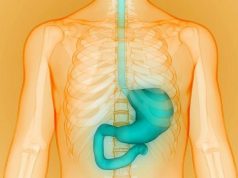Digestive Disease Week 2017
Digestive Disease Week, sponsored by the American Association for the Study of Liver Diseases, American Gastroenterological Association, American Society for Gastrointestinal Endoscopy, and Society for Surgery of the Alimentary Tract, was held from May 6 to 9 in Chicago and attracted approximately 16,000 participants from around the world, including researchers and academics in the fields of gastroenterology, hepatology, endoscopy, and gastrointestinal surgery.
In a placebo-controlled, randomized, prospective study, Maria Claudia Perez, M.D., of Takeda Pharmaceuticals in Deerfield, Ill., and colleagues evaluated 115 healthy postmenopausal women with low bone mass who received dexlansoprazole 60 mg, esomeprazole 40 mg, or placebo for six months.
“In the last decade, several observational studies have suggested a possible association between the use of proton pump inhibitor (PPI) therapy and risk of bone fractures. The findings of these studies have not been consistent, and other factors cannot be ruled out as the cause of fractures,” Perez said. “Based on these findings, we worked in collaboration with the U.S. Food and Drug Administration to design a study to assess any potential mechanisms by which PPIs might induce bone loss.”
The investigators observed no significant changes in bone mineral density, serum phosphorus, serum or urine calcium or magnesium, parathyroid hormone, or vitamin D levels in the study participants.
“There were small increases in bone turnover markers in women taking PPIs compared to placebo; however, these changes remained within normal ranges,” Perez said. “Lastly, some studies have suggested that increased gastric pH may reduce calcium absorption. Therefore, we studied this in a subset of women and found no evidence that PPI therapy affects intestinal calcium absorption.”
Several authors disclosed financial ties to Takeda Pharmaceuticals, the manufacturer of dexlansoprazole, and AbbVie.
Abstract No. 240
In another study, Ashwani K Singal, M.D., of the University of Alabama at Birmingham, and colleagues evaluated the benefit of text messaging among patients with nonalcoholic fatty liver disease (NAFLD).
“The text messages were sent from a central website owned by CareMessage and they were delivered to patients three times per week. One of three messages every week was a two-way message and the other two messages were one-way. The messages ranged from educating the patient, checking the progress of the patient, and reiterating recommendations given in the clinic,” Singal said.
The investigators randomized a total of 30 NAFLD patients to receive instructions either while at the clinic or in additional text messages. Patients were then reevaluated in the clinic six months after initial enrollment. Variables such as weight, body mass index, alanine aminotransferase (ALT), aspartate aminotransferase (AST), triglycerides, and high-density lipoprotein (HDL) cholesterol were assessed at baseline and at the end of the six-month study.
“We found that in the text messaging group, patients lost 11.2 lbs, compared to a weight gain of 2 lbs in the control group. In addition, ALT dropped by 20 IU/L versus no significant change in the control group. AST dropped by 15 IU/L in the text messaging group, without any significant change in control group. Serum triglycerides dropped in the text messaging group by an average of 42 mg/dL, with no significant change in the control group. HDL did not change in either of the groups,” Singal said. “The results were encouraging with a small sample size. In the absence of fatty liver disease treatment options, if we can optimize the recommendations and implement weight loss using this strategy, we can potentially improve outcomes.”
Abstract No. 355
Winston Dunn, M.D., of the University of Kansas Medical Center in Kansas City, and colleagues evaluated a genetic factor to determine which patients with decompensated cirrhosis get better after treatment of the hepatitis C virus (HCV) and which patients do not.
“Almost all patients with HCV can be cured. Sadly, 5 percent of patients are already exhibiting extensive liver damage upon treatment,” Dunn said. “Even if the current direct-acting antivirals are able to cure the virus, it may not be enough. About one-half to two-thirds of patients with decompensated cirrhosis get better. Others struggle with the condition or even get worse, despite the virus being cured.”
The investigators found that the PNPLA3 gene, a gene previously found to be predictive of fatty liver disease and cirrhosis, was also predictive of recovery in this setting.
“Roughly, the effect of having an unfavorable allele, G allele, is the equivalent of having a two-point higher Child Pugh Score,” Dunn said. “Ultimately, we want to be able to inform clinicians which patients will need a liver transplant and which patients will improve and not require a transplant. However, there may be other factors and other genes involved. PNPLA3 is the first gene predictive of recovery but it is currently not available in clinical practice.”
DDW: Bariatric Balloon Capsule Shows Promise for Weight Loss
TUESDAY, May 9, 2017 (HealthDay News) — A new type of “balloon-in-a-pill” may offer a nonsurgical way for obese people to lose weight — and get healthier, too, according to research presented at the annual Digestive Disease Week, held from May 6 to 9 in Chicago.
DDW: Autonomously-Controlled ‘Capsule Robot’ Can Explore Colon
TUESDAY, May 9, 2017 (HealthDay News) — A capsule robot shows potential in gastrointestinal tract diagnostics, and also demonstrates capability for therapeutic maneuvers, according to a study presented at the annual Digestive Disease Week, held from May 6 to 9 in Chicago.
Copyright © 2017 HealthDay. All rights reserved.







